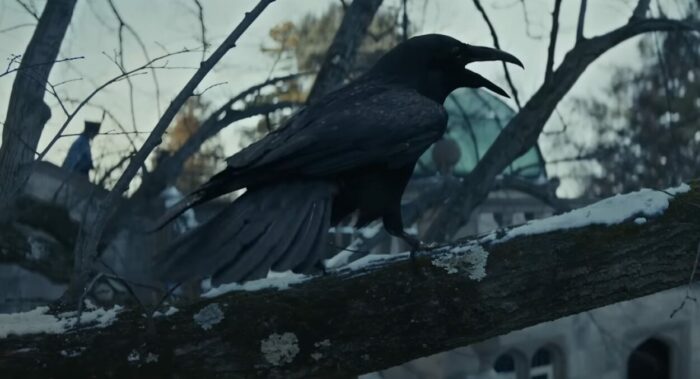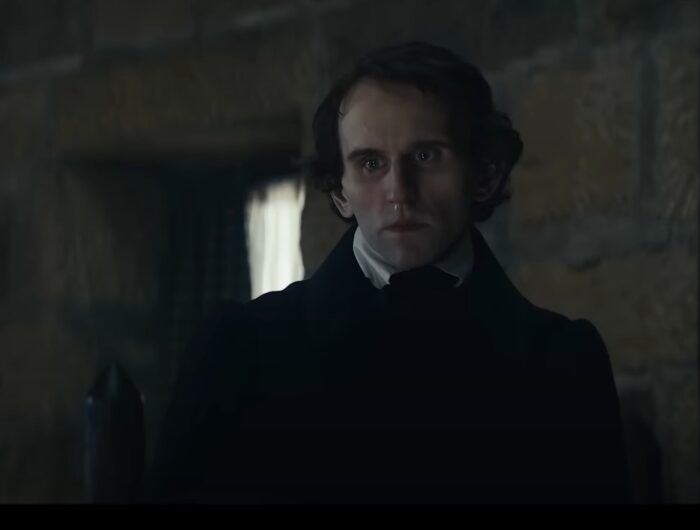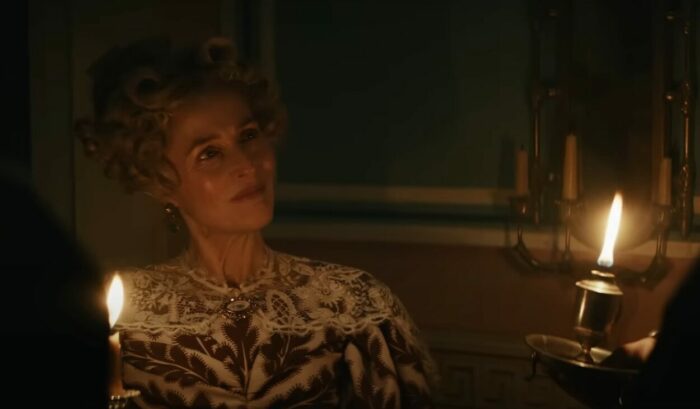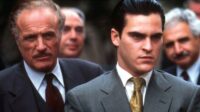Nothing is more mysterious than the minds of others, a fact made clear in The Pale Blue Eye. This historical detective drama, set in 1830, is a psychological exploration wrapped in a murder mystery. Consequently, it isn’t much of a mystery, though it is a compelling look at people with murder on the mind. Its strength is not puzzling out whodunnit but the slow-burn revelation of motivations.
Helmed by writer-director Scott Cooper, The Pale Blue Eye is an adaptation of a book by Louis Bayard. The story follows Christian Bale as investigator Augustus Landor. Charged with solving the murder of a cadet at the U.S. Military Academy West Point, the detective soon employs the assistance of an odd young fellow named Edgar Allan Poe. As the mystery deepens occult overtones arise and more death arrives implying all manner of sinister implications.
Although many are familiar with the more macabre works of Edgar Allan Poe, some may be unaware he conceived the first modern detective story. These two facets of his literary endeavors come together nicely in The Pale Blue Eye. Despite events being entirely fictional, the plot serves up an interesting sort of what if origin story. Thanks in no small part to a fabulous performance by Harry Melling, the audience can see seeds of who Poe becomes taking deeper root.

Glimpses into characters’ psychology are a staple of Scott Cooper’s cinematic efforts. As such, The Pale Blue Eye takes the time to allow for pensive moments without dialogue. Some scenes unfold in relative silence while performers express as much as possible solely through body language and facial expressions. When that isn’t enough, composer Howard Shore musically suggests emotions, while cinematographer Masanobu Takayanagi assists by cementing the film’s visual tone, oscillating between pervasive darkness and murky radiance when necessary.
It’s something seen a lot in Cooper’s previous films such as Out of the Furnace (2013) and Hostiles (2017), movies which also starred Christian Bale and featured quiet, potent scenes of him pondering weighty notions straining his character’s nerves. What’s said often isn’t as important as how it is said. Fortunately, there isn’t a bad performance in the mix. The Pale Blue Eye is filled with a fabulous ensemble composed of skilled players such as Toby Jones, Gillian Anderson, Timothy Spall, Lucy Boynton, and Robert Duvall.
Gillian Anderson, in particular, does some phenomenal acting. Her mere inflection twists certain statements into remarks as unpleasant as paper cuts to the webbing between fingers. Although she regrettably doesn’t get much screen time, there’s a definite sense of depth stemming from her performance.

At the heart of the film, however, are the performances of Harry Melling and Christian Bale. Melling is a touching combination of awkward charm and fragile vulnerability. His Poe is an intelligent individual confidently hiding his frailties. Christian Bale meanwhile gives a solid show, though the brooding fellow tortured by private trauma seems kind of effortless for him at this point. It’s a role he’s occupied expertly in so many movies it would be more surprising to see him fail at it. If there’s an actor equivalent of muscle memory, he’s got it for this type of part.
Sadly, the actual mystery is not much of a head-scratcher. It’s actually one of the weaker aspects of the film. Many of the clues are blunt facts. The only reason no one noticed or explored them is because none of the characters except for Bale’s detective wants to look for them. While there are a few moments of clever ratiocination à la Sherlock Holmes (or perhaps more appropriately C. Auguste Dupin), not unlike Poe’s “Purloined Letter” a lot of the evidence is in plain sight. The mystery in The Pale Blue Eye isn’t so much clever extrapolations from a sharp intellect as it is one person bluntly unafraid to follow the facts. That makes the movie less a whodunnit than a noirish tragedy. Murder and mystery may be catalysts propelling the plot into action, but it’s really the psychological toil of events that drives the movie.
That said, like many good mysteries, there is a quality twist at the end of The Pale Blue Eye. No desire to risk spoiling things, suffice it to say what transpires doesn’t change the mystery or the outcome. Yet, the twist reshapes things enough to change perspective on the why of the crime.

Besides featuring fabulous performances, The Pale Blue Eye does some wonderful work with visual atmospheres. Fog shrouded woods surround, and conversations in low tones occur in a dimly lit tavern. Murder victims are not gory yet remain ghastly in their realism. An air of menace is everywhere, especially along the dark path home.
The only downside being there’s never any real break from the omnipresent gloom. Even moments where light abounds a certain implicative murkiness pervades the scene. It’s not out of sync with the film’s tone, but a single note steadily loses its impact. What starts out ominous yet enticing becomes mundane by the movie’s end.
Another stumbling point is the lack of screen presence for female characters. Whenever onscreen, they do excellent work, and one doesn’t necessarily need a half hour to flesh out a character, but it feels like lost opportunities given the quality of those here. For instance, having an award-winning performer like Charlotte Gainsbourg in a role whose sole purpose is giving men an excuse for exposition dumps feels like a waste.
The pace may also alienate some. This isn’t a high-octane thriller racing to outpace a killer. The Pale Blue Eye is a funeral march to an existential grave where optimism is buried deep.
Still, standout performances by Harry Melling and Gillian Anderson are a real treat. The endless gloom may lose its bite but never its quality. The mystery is hardly a puzzle, but what happened is less important than why. Those in the mood for a noirish drama about maddening desperation and betrayal would do well to watch The Pale Blue Eye.
The Pale Blue Eye is available for streaming on Netflix January 6th, 2023.


